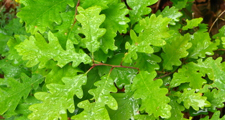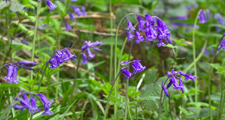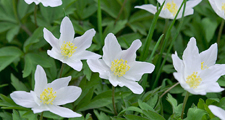Lowland Oak Woodland – W10
Quercus robur – Pteridium aquilinum – Rubus fruticosus woodland.
Region
Widespread on moderately acidic or neutral soils across the county.
Character
Existing semi-natural features are mostly riparian woodlands related to minor valleys, ravines, bluffs and river terraces.
Geology
Base poor superficial deposits. Boulder clays. Sands & gravels. Alluvium.
Soils
Base poor brown earths & gleys.
Species
Common Oak is the dominant species, often Sessile Oak in the upland fringes, and Silver Birch is common. Sycamore may be present in disturbed woodlands. Hazel is often dominant in the understorey. Hawthorn and Holly are common. Ash and Wych Elm are found in smaller numbers as are Rowan, Wild Cherry and Crab Apple. Elder, Blackthorn and Guelder Rose are often present. Small-leaved lime is rare & restricted to a few river gorge sites.
Ground Flora & Fauna
Bluebell and Wood Anemone are characteristic as are Bracken, Foxglove, Red Campion, Wood Sorrel, Wood Sage, Male Fern & Broad Buckler Fern. Bramble, Honeysuckle, Ivy. Ground flora is often strongly influenced by past management.
Structure
Variable. Typically a canopy dominated by Oak and Birch over a well developed understorey, often with under-scrub of Bramble, Honeysuckle or ivy.
Management Principles
- Prevent grazing by livestock or browsing by deer – particularly in small woods.
- Maintain and increase the numbers of old trees and dead wood.
- Progressively remove non-natives at a pace flora & fauna can adapt to.
- Restore coppicing only where its history is well established and the effects on existing flora & fauna are understood.
- Low intervention approaches are best for small woods.
- Timber production – minimise the scale of disturbance.
- Use low-key establishment techniques – particularly natural regeneration.
- When planting is necessary use only native species of local origins.
- Planting sites for new woods Typical woodland type for most of Lowland Durham, for base poor soils on the East Durham Plateau and for much of the Pennine Fringe, penetrating into the uplands on valley floors. Extensions to existing sites.
Design Principles
Planting mixtures based on Oak, Birch, Hawthorn, Hazel and Holly. Others species can be introduced in small numbers or left to colonise naturally. Silver Birch may be used as a nurse species on difficult sites and its proportions in the canopy later reduced. Rare species such as Small-leaved Lime should not be used as their natural distribution could be obscured by indiscriminate planting.
Further Information
Forestry Commission Forestry Practice Guide 3: Lowland Mixed Broadleaved Woods can be downloaded from Forestry Commissions Publications pages.



